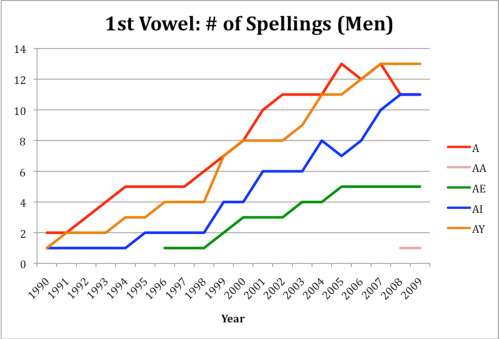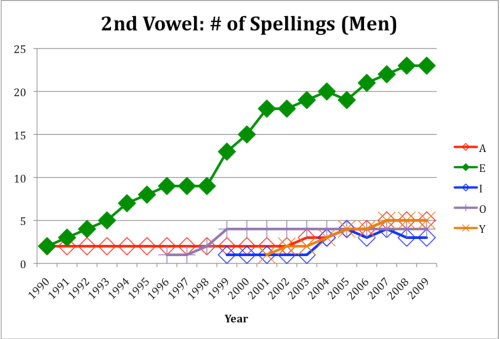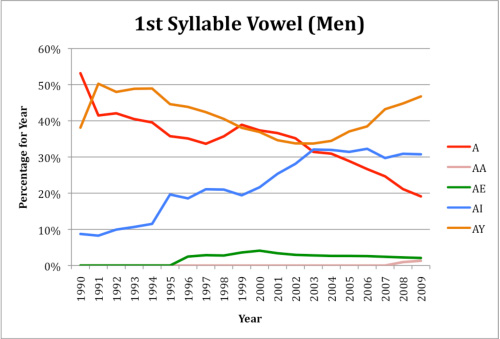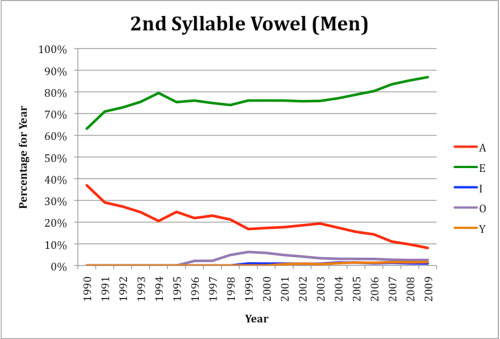
Main Menu - Misc. - Clothing/Textiles - Medieval Wales - Names - Other Medieval - Publications - Harpy Publications
Part II: The diverse roots of the Aidan-Rhyme names
Part III: Near-rhymes and predictions for new candidates for popularity
One of the most common complaints you hear about creativity in modern naming is, "Nobody knows how to spell any more!" And it would certainly be easy to use the explosion of spelling variants among the Aidan-rhyme names as ammunition in this campaign. But recall that when we looked into the possible origins of Braydon, for example, we found exactly the same exuberant variety of spellings. And, of course, there are even more current spellings in use than the ones that make the top 1000 names list. (In 2009 the cut-off to make the list was 194 examples for boys and 263 examples for girls.) Historically, the reasons for the variety in spelling come from several sources:
Whether modern names are part of a continuous tradition of use as given names or whether they're plucked for use from surnames, place-names, names of literary characters, or any other traditional use, all of these historic forces contribute to a wide range of spellings being available for any given pronunciation-group. And while specific spellings may have more or less of a historic basis for a particular derivation for the name, the essence of proper names is that they become arbitrary labels, divorced from semantic meaning. So for all that the baby-name industry makes an enormous fuss over the "meaning" of names, when it comes down to it, in modern American culture, a particular name really only means "this person who bears this name".
The major point I'm trying to make here is that there have always been a wide variety of spellings for these names and there have always been both linguistic and social reasons for spellings to come into existence and to become more or less popular. Even based on the most restrictive criteria, there are many different "right" spellings of these names. There is very little interesting in grousing about these sorts of language changes or innovations. From a researcher's point of view, the interesting part is not what should be happening but what is happening and -- to the extent we can determine it -- why.
To the historic reasons for spelling variations, the modern age has added simple esthetics (preferring the "look" of a particular spelling, for example exchanges of "i" and "y" or preference between "c" and "k") and the desire for individuality (i.e., attempting to come up with a spelling even for a popular name that is not in common use and therefore provides some personal distinction).
The group of Aidan-rhyme names that have made the popularity charts fall in a spelling matrix with five possibilities for the vowel of the first syllable and five (although a slightly different five) for the vowel of the second syllable. With the exception of the C/K alternation for Caden and, of course, the change in the initial sound, the vowels are the only site of variation. (Some of the historic variants of these names included a double "d" in the middle, but none of these have become sufficiently popular to include in this analysis.)
The first vowel can be spelled A, AA, AE, AI, or AY with a strong preference for AY followed by A (and AI the only other serious contender). The second vowel can be A, E, I, O, or Y, with an overwhelming preference for E and A being the only other serious contender. Before we get to the basis for calling these preferences, let's look at the absolute distributions. The following table shows the combinations that appear in the statistical data. (For reasons discussed previously, I'm including the "Adan" group, as it behaves similarly to the Aidan rhymes, but not including the Payton/Clayton/etc. near-rhymes.)
1st Vowel > V 2nd Vowel |
A | AA | AE | AI | AY |
|---|---|---|---|---|---|
| A | Adan | Aedan | Aidan | Aydan, Jaydan |
|
| E | Aden, Braden, Caden, Kaden, Haden, | Aaden | Braeden, Kaeden, Jaeden | Aiden, Braiden, Caiden, Kaiden, Haiden, Jaiden, Raiden, Zaiden | Ayden, Brayden, Cayden, Kayden, Hayden, Jayden, Zayden |
| I | Adin, Kadin | Aydin, Jaydin | |||
| O | Jadon | Braedon | Braydon, Jaydon | ||
| Y | Bradyn, Kadyn, Jadyn | Aidyn, Jaidyn |
So based purely on the number of different spellings, we have the following numbers:
1st vowel
2nd vowel
Some interesting observations:
2nd syllable A is largely confined to variants of Aidan (even though there are historic variants for Caden and Braydon that have A in this position).
1st syllable AA appears only for Aidan, which is not entirely surprising when you think about it. English doesn't normally allow "aa" as a combination, but we're used to seeing it in Aaron and it may be more "acceptable" in the same position at the beginning of the name.
Although AI and AY are both popular for the first vowel, and I and Y are both found for the second vowel, you don't see any combinations that involve #aidin or #aydyn. This isn't to say that those spellings aren't being used. Google easily turns up people in the U.S. using Jaidin and Jaydyn, for example (although the top hits for Aidin and Aydyn appear to be names entirely unrelated to Aidan and not in the U.S.). This sort of avoidance of repeating the same sound (or in this case, letter) in a word is called disssimilation and is yet another common kind of linguistic change. There's no rule that says dissimilation has to happen, but it's not surprising when it does, even apparently randomly.
But we can go a lot deeper than the simple question of what spelling combinations exist. How do the total numbers of the different spelling variants compare to the numbers if distinct names using them? Let's look at them in terms of percentages of the total for each position individually, for each pair of combinations, and for distinct name spellings versus total individuals using the names. This analysis is confined to the period from 1990-2009, so earlier uses of Adan, Hayden, and Braden aren't included. I've rearranged the order of the spellings from most popular to least popular.
| 1st vowel | Spellings | Individuals |
|---|---|---|
| AY | 30% | 41% |
| A | 30% | 25% |
| AI | 26% | 30% |
| AE | 12% | 3% |
| AA | 2% | <1% |
| 2nd vowel | ||
| E | 58% | 82% |
| A | 12% | 13% |
| Y | 12% | 1% |
| O | 9% | 3% |
| I | 9% | 1% |
So while the order of popularity is roughly the same from both angles, the magnitude doesn't always correspond. For example, although E appears in the second syllable in only slightly over half the spellings, those spellings (or at least some of them) are much more popular in actual use, such that 82% of people in this study have names with this spelling. Similarly, the same number of spellings use A and Y in the second syllable, but many fewer people have names using Y. The one major exception to the parallels in relative popularity is 1st syllable A versus AI where the percentages are reversed, with A appearing in more different spellings but AI used by more people.
Putting the pairs together, we get the following percentages for specific combinations. (Again, the spellings have been re-ordered from most to least popular.)
1st vowel > V 2nd vowel |
AY | AI | A | AE | AA | Total |
|---|---|---|---|---|---|---|
| E | 38.6% | 17.8% | 23.0% | 2.1% | 0.3% | 81.8% |
| A | 0.5% | 12.2% | 0.2% | 12.9% | ||
| O | 1.9% | 0.9% | 0.4% | 3.2% | ||
| Y | 0.3% | 0.8% | 1.2% | |||
| I | 0.5% | 0.5% | 1.0% | |||
| Total | 41.4% | 30.3% | 25.3% | 2.6% | 0.3% | 100.0% |
If the distribution of overall numbers were simply a reflection of the popularity of the individual components (with exceptions for things like dissimilation as noted above) then we'd expect a general shading down from the upper left corner, which is mostly the case. Not at all surprisingly, the intersection between the two most popular options (#ayden) is also the most popular combination at nearly 40%. The combination #aydan looks unexpectedly unpopular, but keep in mind that the 2nd syllable A occurs primarily in Aidan, and the spellings of Aidan show a strong preference for the original AI in the 1st syllable. So the "lump" of population in the second row is shifted over towards the AI column for historic reasons to do with this particular name.
We can also track changes in the popularity of different spellings over time. The first pair of graphs shows the number of different spellings in the top 1000 names each year.
For the vowel(s) of the first syllable, although there's a clear hierarchy of popularity, new spellings are added at a similar rate each year for each. (AA is the exception, but as noted above, it's only likely to be considered acceptable in variants of Aidan.)

(I've added markers to the next graph to help distinguish the lines when they fall together.)
In contrast, the creation of new spellings with E as the vowel in the second syllable increases steadily throughout the period of investigation, but spellings with other vowels tend to remain static for long periods of time. The innovation that we saw for the first vowel is operating primarily to create new combinations of initial consonants and first vowels, not new combinations with second vowels.

When we look at the yearly trends for the total percentage of Aidan-rhyme names with each vowel in each position, we can see how the overall dominance is created. Keep in mind that along with the increase in new ways to spell the names, the overall numbers of people using the names is increasing even faster. So although we saw all the different options for the first vowel increasing with respect to the different spellings using them, that doesn't translate into increases in "market share". (It couldn't, since market share is a zero-sum game.) We can discount the participation of AE and AA which appear at low, but steady, percentages once they make the charts. Initially, A and AY dominate the field with fairly similar percentages, while AI is clearly a minority option. (The odd position-swap between A and AY between 1990 and 1991 is entirely due to the suddent jump of "Hayden" in 1991.) Up until around 2003 AI steadily takes over at the expense of the other two, but then something curious happens. AI levels out and now the decline of A is balanced by a renewed interest in the AY spelling.
This trend happens across the board. For the Aidan group, AI spellings are, on the whole, levelling off while AY is still increasing in this period, Brayden is still increasing sharply while Braden starts to decline, Caden/Kaden has crested and started to fall while Cayden/Kayden is still increasing, Hayden has crested and started to fall, and both Jaden and Jaiden have levelled out while Jayden is increased its rate of climb. So this more recent spelling shift isn't driven by changes in the popularity of any one specific name, but by changing choices among the options for each name group.

As we noted above, for the vowel of the second syllable, E increases sharply in the number of spellings using it while the other options increase only slightly if at all. From this you might expect that the overall market share of E would also increase steadily but this isn't the case at all.
For the period from 1990-1994 there is an increase in E and corresponding decrease in A (the other options aren't in play yet at this point). During this period the A spellings are represented only by Aidan and Adan, with the former increasing in use and the latter holding steady. But the E spellings not only start out with Braden and Hayden as they increase steadily, but all the new names being added during this period use the E spelling (Caden, Kaden, Jaden, Brayden, Jayden).
Yet even though spellings using E continue multiplying at a much faster rate, the "market share" between A and E holds essentially steady until 2003 -- roughly the same point when we saw a change of direction in the trends for the first vowel. After that, E continues its upward climb while A drifts steadily downwards. The specific event that this best correlates with is the spelling Aidan hitting its peak and starting to decline in absolute usage numbers.

If there is any truth to my starting assumption that the overall trend for the rhyme was started by Aidan, this shift may be the signal of the beginning of the end. At the very least, it signals a dissociation of the trend from the original spelling for Aidan and a hand-off to #ayden as the conceptual nucleus of the rhyme-group.
The spelling trends for the core Aidan-rhyme group give further evidence regarding the non-inclusion of the Payton/Clayton/etc. names in this trend. Although we see a little allowance for EY in the first syllable, the Payton-rhyme names universally retain the O in the second syllable, at least in spellings that make the top 1000. (Oh, you can find the occasional #ayten name in a Google search, but even Google "corects" Clayten to Clayton, returns only "Day ten" for Dayten, and inquires whether you really wanted Peyton rather than Peyten.
In contrast, the collection of Adan/Aden/Adin (whether or not it's historically valid to group them together) behaves very similarly to Aidan, with the earliest form Adan gradually being supplanted by newcomer Aden, with Adin running a far far third from both. So including this group in the Aidan rhymes seems the reasonable thing to do.
One of the really fun things about this sort of name research is that the answer to every question raises several other questions. While I can't guarantee that every interesting topic will eventually be addressed, here are some of the questions I've jotted down in the course of this article (as well as the questions that were already on my list that are cross-referenced in the discussions here).
Return to Index of Name Essays
This site belongs to Heather Rose Jones. Contact me regarding anything beyond personal, individual use of this material.
Unless otherwise noted, all contents are copyright by Heather Rose Jones, all rights reserved.